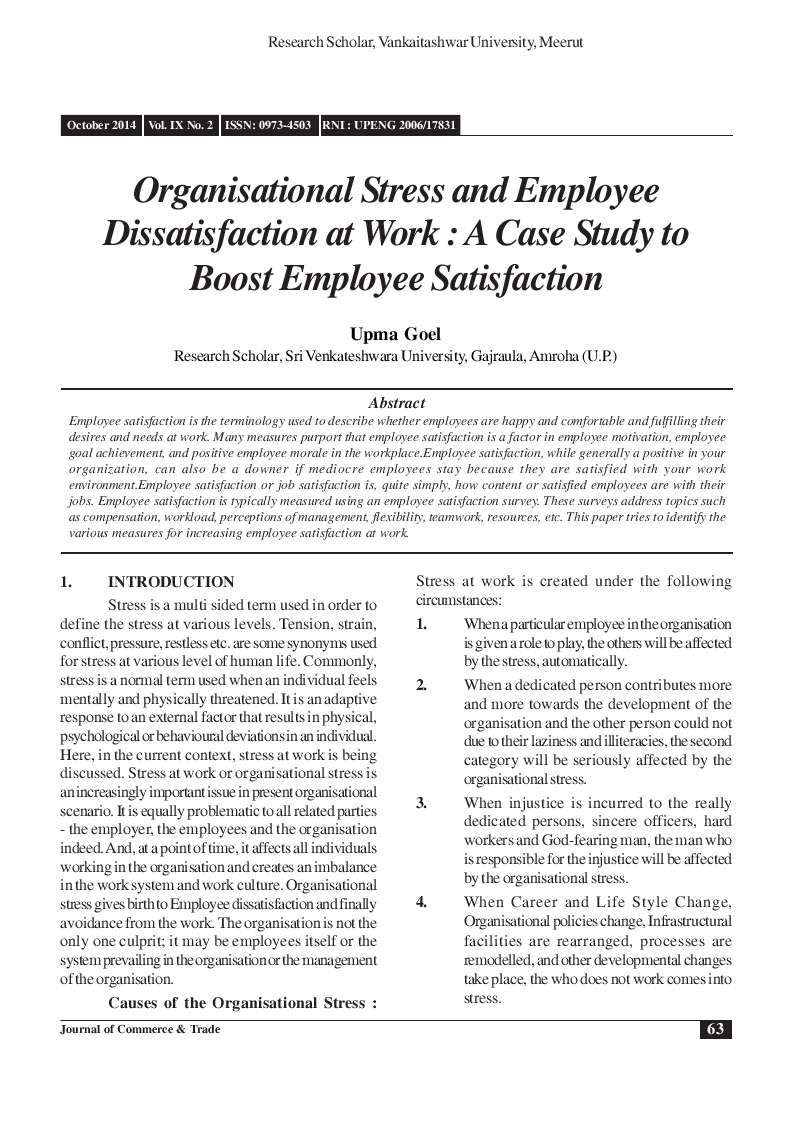Organisational Stress and Employee Dissatisfaction at Work: A Case Study to Boost Employee Satisfaction
DOI:
https://doi.org/10.26703/jct.v9i2.260Keywords:
Organisational Stress, Employee DissatisfactionAbstract
Employee satisfaction is the terminology used to describe whether employees are happy and comfortable and fulfilling their desires and needs at work. Many measures purport that employee satisfaction is a factor in employee motivation, employee goal achievement, and positive employee morale in the workplace.Employee satisfaction, while generally a positive in your organization, can also be a downer if mediocre employees stay because they are satisfied with your work environment.Employee satisfaction or job satisfaction is, quite simply, how content or satisfied employees are with their jobs. Employee satisfaction is typically measured using an employee satisfaction survey. These surveys address topics such as compensation, workload, perceptions of management, flexibility, teamwork, resources, etc. This paper tries to identify the various measures for increasing employee satisfaction at work.
Downloads
Metrics
References
Bhatti, K., & Qureshi, T. (2007). Impact of employee participation on job satisfaction, employee commitment and employee productivity. International Review of Business Research Papers, 3(2), 54 – 68.
Bowen, D. E., & Ostroff, C. (2004). Understanding HRM-firm performance linkages: The role of “strength” of the HR system. Academy of Management Review, 29, 203-221
Carpitella, Bill. (2003). Make residential construction the industry of choice [Electronic version]. Professional Builder, Oct 2003.
Cranny, C.J., Smith, P.C., & Stone, E.F. (1992). Job satisfaction: How people feel about their jobs and how it affects their performance. New York: Lexington.
Derek R. Allen, Merris Wilburn, (2002) –Linking customer and employee satisfaction to the bottom line, ASQ quality press publications cat log, Milaukee, WI.
Employee satisfaction and opinion surveys. (n.d.). Retrieved February 25, 2011, fromhttp://www.infoquestcrm.co.uk/employee_surveys.html
Freeman, Shelly, (2005). Employee satisfaction: The key to a successful company.Retrieved on
March 15, 2011http://library.lp.findlaw.com/articles/file/00301/008927/title/Subject/topic/Employment.
Harter, J. K., Schmidt, F. L., & Hayes, T. L. (2002). Business-unit level relationship between employee satisfaction, employee engagement, and business outcomes: A meta-analysis. Journal of Applied Psychology, 87, 268-279.
Heskett, J. L., T. O. Jones, G. W. Loveman, W. E. Jr. Sasser, L. A. Schlesinger. 1994. Putting the service-profit chain to work. Harvard Business Review 72 (2)
Hunter, W., & Tietyen, D. (1997). Business to business marketing: Creating a community of customers. Lincolnwood-Illinois, McGraw-Hill Professional.
Judge, T.A., Hulin, C.L. (1993), “Job satisfaction as a reflection of a disposition: amultiple source causal analysis”, Organizational Behavior and Human Decisions Processes, Vol. 56, pp. 388-421.
Likert, R. L. (1961). The human organization. New York: McGraw-Hill.
Maloney, W.F., & McFillen, J.M. (1986). Motivational implications of constructionwork. Journal of Construction Engineering and Management, March 1986, 137-151.
McGregor, D. (1960). The human side of enterprise. New York: McGraw-Hill.
Miller, J. L. (2006). Coach Yourself to Succeed @ Work: How to Achieve Optimal Performance and Job Satisfaction.CA, Dorrance Publishing Co.
Moyes, G. D., & Shao, L. P., Newsome, M. (2008). Comparative analysis of employee job satisfaction in the accounting profession. Journal of Business & Economics Research, 6(2), 65-81
Nancy C. Morse , (1977)-Satisfactions in the white-collar job, Ayer publishing.
Rousseau, D. (1978), “Characteristics of departments, positions, and individuals:Contexts for attitudes and behaviors”, Administrative Science Quarterly,;Vol. 23, pp. 521–540.
Spector, P.E. (1997). Job Satisfaction: Application, Assessment, Causes, and Consequences. Thousand Oaks, CA: Sage.
Susan M Heathfield, Employee Satisfaction, retrieved from About.com on 23 Nov. 2011- http://humanresources.about.com/od/employeesurvey1/g/employee_satisfy.htm
U.S. Bureau of Labor Statistics. (2004). Occupational Outlook Handbook. WashingtonDC: McGraw-Hill.
Wright, P. M., Dunford, B. B., & Snell, S. A. (2001). Human resources and the resource-based view of the firm. Journal of Management, 18, 295-320.
Wright, P. M., Gardner, T. M., Moynihan, L. M., & Allen, M. R. (2005). The relationshipbetween HR practices and firm performance: Examining causal order. PersonnelPsychology, 58, 409-446.
Argyrus, Chris, Personality and Organisation, New York Harper and Row, Publishers, 1951
Bech, Dala S. Personnel; Management of People At Work, New Youk, 1965
Rajavel, N, How to Ensure Faster the Growth in Andaman and Nicobar Islands, Industrial Herald, Jan., 16-31. Madras 1996
Rajavel, N., Tourism in Andaman and Nicobar Islands. Delhi, Manas Publication, 1998
Rajavel. N, Planning for Growth s Development, Kalpaz Publications, Delhi – 52, 2006
Rajavel. N. ‘‘A Study on Academic Freedom in the Quality of Higher Education’’ New Frontier In Education (J), Vlo.40 No. 4 Oct- Dec 2007
Whyte W F, Man and Oraganisation ( Homewood, III. Ricahard D Irwin Inc.., 1959)

Additional Files
Published
How to Cite
Issue
Section
License
Copyright (c) 2014 Journal of Commerce and Trade

This work is licensed under a Creative Commons Attribution 4.0 International License.







